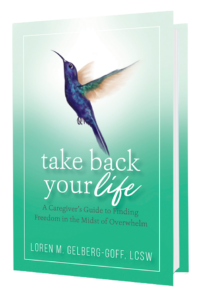Welcome to Part 3 of our series on Setting Boundaries.
This article is all about how to handle your own reactions and restore your equilibrium in challenging moments. It will come in handy when you start to question whether you’re doing the right thing setting a boundary, especially one that feels uncomfortable, with someone important to you.
Yes, we’re still discussing Boundaries, and that’s because they are so difficult for so many to establish, maintain and reinforce. I just wanted to share a few more important points about the process and experience of giving ourselves this powerful “gift that lasts a lifetime.”
Whether it’s at work, at home, in the community or with friends, boundaries are one of the first ways we show that we are taking care of ourselves. You probably never thought about boundaries that way, right? But it’s really true. So many other problems arise – not just in caregiving but throughout life! – if we don’t get this first job of self-care handled well.
So, how are your new boundaries fitting you so far? How are the people in your life reacting in response?
I’m guessing it’s not all going perfectly smoothly for any of you, because it really is an art that we all need to master over time. The urge to turn and run back to comfortable patterns is strong, and will show up just when you’re on the verge of a real breakthrough.
For example, this question I received this week is put to me all the time in various guises, but the issue is the same:
“When I say “no” I feel like I’m being a b***h” – and I feel like I sound so harsh.”
Who wants to be seen as a b***h? Or maybe even actually BE one? Nobody! That will appear, in the moment it occurs to you, as an awfully strong incentive to drop your new boundary requests and go back to being “helpful.”
So while last time I wrote a lot about the other person’s feelings, and your need to be aware and respectful of them, today I’m focusing more on YOUR feelings. You need to master your own inner conversation so you don’t get drawn right back into those old patterns because you want to avoid being a “bad person.”
So let’s start by looking at the differences between our Thoughts, our Judgments and our Feelings.
First of all, even though when you have a Thought about your uncomfortable new situation, and you might use the word “Feel” as in the above quote, understand that labeling oneself a b***h is NOT a Feeling. “Feeling like I sound harsh” is also not a Feeling. These are actually Judgments.
True Feelings are transient. They ebb and flow. If saying “no” is new for you, you will experience discomfort, uncertainty and even fear. Those can be extremely powerful Feelings…and we breathe! So first, start to separate the Thought , and the Judgment about that Thought, from the Feeling about the idea of having that Judgment made about you.
Know that you will experience these feelings, or others equally powerful, whenever you do something that is not your usual behavior. If the first thought that generally pops up when you even think about doing something new and different is that what you’re doing is “wrong,” that you’re a “b***h,” or that you are “harsh,” you need to understand that these are judgments from others that you have accepted as true.
Also, because you have just accepted them as true, because you believed the original source they came from, you have therefore never explored objectively how you might feel if you ever did say “no.” So let’s do that now.
Someone may be upset, annoyed, inconvenienced, etc. if you actually do say “no” to their request. We talked in the last article about how to understand and be compassionate toward their reactions and feelings. But if you say “yes” to them, how will you feel? Will you be upset, annoyed, inconvenienced, etc.? If so, ask yourself, “Why would that be ok or acceptable, other than because it’s just the norm?”
So you’re no doubt asking, “Well, how do I say ‘no’ and avoid feeling like that?” Well, we all can learn to say “no” with compassion, and that makes a huge difference to you and the person you’re saying it to. Rather than operating from a space of anger, resentment and frustration over being asked, yet again, for yet another favor, request, demand, etc., you can gently and compassionately decline. And now, by processing your inner conversation effectively, you won’t have to cope with lots of negative feelings as a result.
So let’s get specific about how to do that.
As I said in the first article on this subject, the secret is in applying “The Three Ps”: Practice, Patience and Perseverance. These remain requirements for following the next few steps in learning how to say “no” with compassion:
- BREATHE! Yes, this remains the most important first step, so that you can actually step out of reaction mode and into a more measured response mode.
. - Acknowledge how you feel. This means being aware of your body’s reactions. Does your stomach tighten? Do you become short of breath? Do you feel afraid, tense, nervous, apprehensive? Simply BREATHE through the feelings. Remember, it’s not your feelings that get you into trouble, it’s your actions. So Take NO Actions Now is the rule in this moment!
. - Notice the thoughts that pop into your head. Where did they come from? How did you learn them? As brilliant as you may be, those thoughts did not spring spontaneously into your head. They all came originally from someone else – try to clarify whose voice is really talking when you think those thoughts.
. - Are your thoughts true? It’s amazing how long we can go just assuming something is true without questioning it. Just because you have believed them all this time doesn’t make thoughts true. We all often believe “lies masquerading as truths.” Really look at your thoughts objectively and see if they pass the logic test.
. - When you are finally able to say “no,” because it is the best answer for you at that time, state simply and directly: “I am unable to […the request they want you to fulfill…] at this time. I appreciate that may inconvenience you, and while I can’t help you out this time, I hope that I’ll be able to do so at another time.” OR you can say, “While I cannot accommodate your need now, I can help you out on […future date…]. Let me know if that will work for you.”
Practice some short, simple responses such as those above, that are clear and direct without sounding guilty or angry. Simply be sincere, remembering who you must take care of first and foremost in order to maintain the capacity to help anyone else.
~ ~ ~ ~ ~
Remember also that you do not have to go it alone! Take a half hour or so to use my Caregivers Step-By-Step Guide and audio, to get some clarity and begin to shift your mindset.
You can find that freedom in the midst of the overwhelm…really!
Leave your comments, questions or concerns below… I look forward to hearing from you.
And we breathe…




This is an amazing article. I shared it on my Facebook page. Thank you
I’m so glad you found it useful. Thank you for sharing, Martha!!!